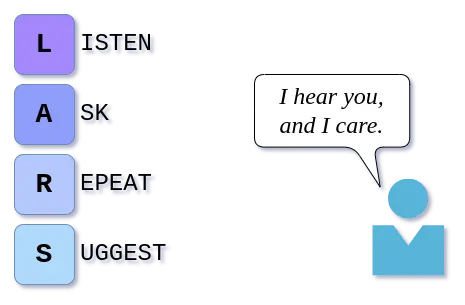Listening to Understand
The LARS Technique for Improved Conversations

Problem statement
You have difficulties connecting with others, and find yourself disengaged during conversations.
Intent
- Be fully present, focusing on understanding your conversational partner.
- Improve your relationships by practising empathetic listening.
- Prioritise listening to understand, rather than simply responding.
Solution
Instead of defaulting to responding, practice empathetic listening using the LARS acronym:
(L)isten: Actively listen to what the other person is saying, resisting the urge to formulate a response immediately. If you find your mind drifting, take a deep breath, and refocus on their words. Non-verbal cues like nodding or acknowledging sounds (“aaahhh”, “hm, hm”, “I see”) can help1.
(A)sk: Engage your conversational partner by asking questions about their perspective, feelings, and needs. This signals your genuine interest and deepens your understanding. Strike a balance between being interested, and interrupting them too often. Try to avoid overwhelming them with excessive questions, and making your conversational partners feel as if they are being interrogated2.
(R)epeat: Validate your understanding by paraphrasing what you’ve heard in your own words. Confirm with your partner that your summary aligns with their message. This reinforces that you’ve genuinely heard and comprehended their words. You can use a variation on one of these formulations to do so: “If I understood correctly …”, “Let me get this straight, you are saying that…”, “So as I understood it, you … . Does that sound right?”, “I will try and summarize to see if I understood correctly, …”.
(S)uggest: After understanding their perspective and needs, offer suggestions or assistance thoughtfully. Ensure your suggestions align with their concerns without trivializing their feelings or experiences. Little is more painful than sharing your feelings, only to be told that you are likely overreacting. Avoid using trivializing words, and platitudes, such as “just”, “easy”, “we’ve all been there”, “that’s nothing, you should hear what I went through”.
Contextual forces
Enablers
The following factors support effective application of the practice:
- Genuine care for the person you’re conversing with and a desire to understand them.
- The topic of conversation is interesting or relevant to you.
- Ability to stay calm and present during conversations.
Deterrents
The following factors prevent effective application of the practice:
- Your own thoughts are overwhelming, making it difficult to empathize with others.
- Formal situations where monologue-style speaking is expected (e.g., work presentations or job interviews).
- Your main job is to solve various problems quickly, and without much interaction (e.g. remote tech support).
- You do not particularly care for the person you are conversing with.
- Feeling rushed during the conversation.
Rationale
In Western society, we often prioritize responding and asserting ourselves in conversations3. However, most people seek conversation for reasons like seeking empathy, getting someone to act, or receiving information. Empathetic listening, defaulting to an “empathy mode,” is usually the key to meaningful connections. When someone talks to you, assume they want to be heard. If in doubt, politely ask what they expect from the conversation.
Application
Consequences
While the LARS technique brings numerous benefits in terms of improving communication and building stronger relationships, it can also lead to some unexpected or undesired outcomes:
- Emotional Drain: Constantly engaging in empathetic listening can be emotionally taxing, especially if you are dealing with emotionally charged topics or if you are naturally empathetic. This may lead to burnout or emotional fatigue over time.
- Misalignment of Expectations: In some cases, your conversational partner may expect advice or solutions rather than empathetic listening. If you default to listening without offering actionable feedback, they might feel frustrated or believe that their concerns are not being addressed.
- Overemphasis on Empathy: Overusing empathetic listening can sometimes prevent the conversation from moving forward to problem-solving or decision-making stages. This may result in conversations that feel unproductive, particularly in professional or goal-oriented settings.
- Increased Vulnerability: By deeply engaging in empathetic listening, you may find yourself becoming more emotionally involved in the problems and concerns of others. This could lead to an increased sense of vulnerability or stress, particularly if you are dealing with multiple emotionally intense conversations.
- Potential for Miscommunication: Despite your best efforts, there is always a risk of misinterpreting someone’s words or emotions, leading to misunderstandings. Paraphrasing and seeking confirmation are essential but can sometimes still result in miscommunication. Especially when you are repeating what you heard there is a risk of your partner regarding you as a parrot, rather than a genuine listener.
Mitigation strategies
To mitigate the potential negative consequences of the LARS technique:
- Set Boundaries: Be mindful of your emotional and mental limits. It’s important to take breaks and engage in self-care practices to prevent burnout. If you find that empathetic listening is becoming too emotionally draining, take a step back and assess how you can manage your emotional involvement.
- Clarify Expectations: Before fully engaging in a conversation, clarify with your conversational partner what they hope to gain from the discussion. This helps ensure that you are meeting their needs, whether they seek empathy, advice, or action.
- Balance Empathy with Action: While empathy is important, recognize when it’s time to shift from empathetic listening to problem-solving or decision-making. This balance helps ensure that conversations are both meaningful and productive.
- Protect Your Emotional Well-being: Recognize when you are becoming too emotionally involved in someone else’s issues. Establish emotional boundaries and practice self-awareness to avoid taking on too much emotional burden.
- Refine Paraphrasing Techniques: Continuously practice and refine your paraphrasing skills to minimize the risk of miscommunication. Ask follow-up questions to ensure that your understanding is accurate and aligns with the speaker’s intent.
Examples
Take a moment to tune in to popular talk shows and interview-focused podcasts. Pay close attention to how the hosts skilfully bring out the best in their guests. The best hosts have a unique talent for getting their guests to open up, creating an atmosphere where the guest shines and feels like the most captivating person in the world.
Now, let’s contrast this with the style of “pundits” or “talking heads” on shows that thrive on hot takes, monologues, and criticism of current events or famous individuals. Think about sports shows or political debate programs – they often fit this description perfectly.
Now, consider this: If you were to be interviewed, who would you prefer to be your host? Someone who genuinely aims to make you shine, or someone who seems more interested in tearing you down?
Here’s the real question: What type of host do you aim to be in your own conversations? The answer may hold the key to more meaningful and impactful interactions.
Criticism & Clarifications
- LARS is not always the fastest route to decisions—align expectations when agendas require concrete outcomes or time-boxed meetings.
- Some partners may perceive paraphrasing as insincere; model curiosity and adapt the cadence so the exchange still feels natural.
- Empathetic listening complements, rather than replaces, professional support; encourage people to seek specialists when conversations surface deeper trauma or therapy needs.
Individuals who struggle with staying “passive” physically or verbally can try techniques like fidgeting with noiseless objects or engaging in doodling or note-taking during conversations to maintain focus. ↩︎
Finding the right balance in asking questions depends on your conversational partner’s preferences. Pay attention to their cues, practice, and consider asking them when in doubt. ↩︎
For instance, political debates often highlight participants’ focus on asserting their viewpoints rather than truly listening, building on top of, or responding to arguments made by other participants. ↩︎
